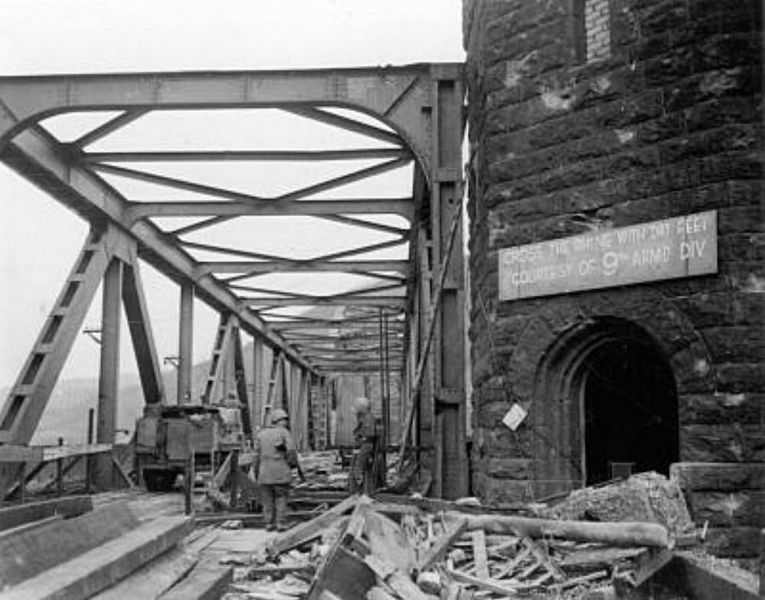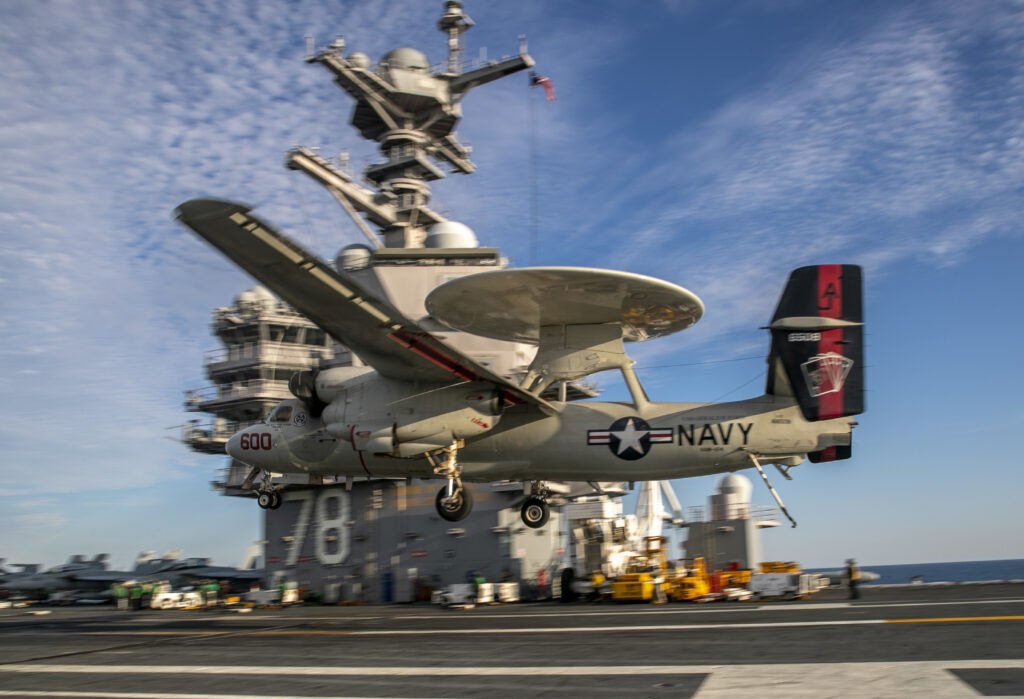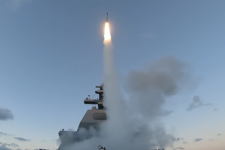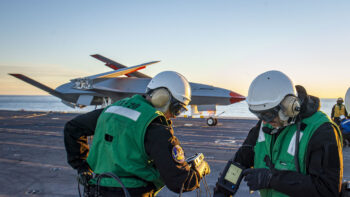
US troops on the Ludendorff Bridge over the Rhine at Remagen before it collapsed under German bombardment.
The Pentagon must avoid the ancient Roman tactic of “burning the bridge behind them” by immediately throwing aside older weapons systems in favor of wholesale investments in new technologies and platforms. While force modernization is necessary, the Department of Defense does not have the time, track record, or the funding to rapidly field replacements to legacy systems. Besides, in many cases the Pentagon doesn’t need entirely new systems; it only needs new tech on old stuff.
Just look at the track record from the Rumsfeld era of failed transformations – the Future Combat Systems, Joint Strike Fighter and the Littoral Combat Ship – to see the risks.

Invention and innovation are not the same thing. The Pentagon was the inventor from the 1940s through the ‘80s, giving the world the Internet, email, computer mouse and so much more. Now it must be the innovator—using existing platforms as technological playgrounds. Innovation is about putting things together that already exist to create a different and better outcome. Innovation is not, however, a program of record. Take the Army’s next generation soldier wearable augmented reality headset called the Integrated Visual Augmentation System (IVAS) as an example. These sunglass-sized goggles provide “next-level night and thermal vision while also adding in layers of other actions such as navigation and targeting.” In building the latest version of the VR-headset, the Army put video gaming coders from Microsoft in the field next to soldiers to update the technology in real time. The Army also acquired this capability using non-traditional partners and unconventional funding to go even faster.
Meeting new threats requires a clear understanding of a matrix of interlocking facts: legacy systems still add value, emerging technologies can (and must) be integrated in older platforms, and there are deceptively obvious best-practices that should be prioritized. The Army offers a strong model to follow. The service is currently fielding IVAS, an improved Bradley Fighting Vehicle, and the Armored Multi-Purpose Vehicle—all trying to integrate leap-ahead technologies into older platforms in a cost effective and successful manner.
First, services must determine what constitutes a legacy weapons system. That is crucial for identifying which programs are ripe for cuts as defense budget toplines flatten, and which should be preserved. Legacy platforms are usually discussed as the oldest iterations of a weapons systems in the services. such as A-10s, AWACS and JSTARS C2, U-2s, F-18s, cruisers, and more.
Regardless of how many dollars—or how few—are given to the Pentagon, over three-quarters of the forces fighting today will be the same in 2030 due to production schedules, industrial base constraints, and previous investment decisions. Sometimes when it tries to leapfrog a generation, the Pentagon can hide behind Power Point slides that promise to do the equivalent of making your toaster talk to your streaming service (just be sure to connect it with a lightning bolt in the slides) instead of executing the more accountable and immediate task of integrating driver-assisted technology into its wheeled fleet today.
New technologies will challenge the Pentagon to think differently. Nand Mulchandani, acting director of the Joint Artificial Intelligence Center (JAIC), has distilled this problem. Hardware—like ships, aircraft, and vehicles—is much harder and slower to update than software. So conceptualizing modernization purely in terms of the age of platforms is unimaginative and unproductive. But the Pentagon processes are still rooted in and reward the development of new platforms, leaving those who want to interject new technologies facing the choice of trying to start new programs.
HASC Chairman Adam Smith recently put it this way: “It’s not necessarily about whether it’s a legacy platform or it’s a new platform… If you make systems that can survive, that’s what we’re looking for.” For example, the Army’s current efforts to link targeting data from new satellites, drones and sensors to shooters like a Grey Eagle relies on the improved efficiency of new data processing centers powered by AI. That kind of incremental approach can buy the Pentagon valuable time today to bridge the gap to tomorrow and enables non-traditional defense firms that have trouble competing for the “tear-down” rebuilds of a new start program. The military can either simply screw on a new doorbell camera to the doorframe, or it can try to build a new house with the doorbell built in.
Of course, not all legacy systems are created equal and retrofitting your toaster to stream videos is probably not cost effective, and you still need toast today. Some legacy systems will be able to absorb new software and new technologies; others cannot. That should be a deciding factor. Aircraft carriers are a good example. The Ford-class carrier is powered by nuclear reactors that produce more than three times the electrical power of its predecessor, the Nimitz-class.

An E-2C Hawkeye lands on USS Gerald R. Ford Nov. 14, 2020.
As a result, the Ford can support new weapons that will require lots of power, like directed energy, rail guns, and lasers. The Nimitz cannot, so concerns about its survivability in a high-end fight abound. The Pentagon’s working with the commercial tech sector to upgrade the military’s legacy systems can lead to better weapons in ways similar to how easy and inexpensive it is to retrofit a rearview camera to an automobile today. Why shouldn’t every military wheeled vehicle have this capability immediately?
As new weapons systems are designed and emerging technologies are incorporated across the force, shared standards are crucial. Lt. Gen. Jack Shanahan, former lead of Project Maven and the first director of the JAIC, outlined the challenge: “Every weapons system that we have, and every piece of data that we have, conforms to some standard. There are over a thousand different standards related to data today. They’re just not all enforced.” To be effective, standards need to be monopolistic and open.
We cannot allow each platform (or company) to set their own standards. This is where DoD and Congress need to make hard decisions. The largest stumbling block is allowing each defense contractor to pick and choose solutions for incorporating emerging technology in new weapons systems thus ensuring no shared baseline will become standard. Common plumbing, so to speak, must be designed and laid out.
The Army wants autonomous combat vehicles but is stuck with a “dumb” tank in the Abrams. The Army doesn’t need a brand new tank when it can use driver-assisted technology from the commercial sector on some of its legacy vehicles. Injecting cutting-edge technology onto legacy systems is one way to avoid having contractors come up with proprietary solutions that are all different among systems. Take also the Army’s military-version of the Hummer: it is the same as it was in 1980. Meanwhile, General Motors’ commercial Hummer is fully electric and charged, fully networked and emits zero emissions.
The Pentagon and Congress have hard choices to make in order to modernize the force. We should not be trapped by the same failed Game of Thrones-like competition that sets legacy weapons against modernized technologies. Instead, set the conditions for a more nuanced discussion of modernizing our legacy systems with today’s technology now while waiting for the promises of tomorrow to materialize.
Mackenzie Eaglen is a defense expert at the American Enterprise Institute and member of the Breaking Defense Board of Contributors.
John Ferrari is a visiting fellow at the American Enterprise Institute (AEI) and the chief administrative officer at QOMPLX, a data analytics and cybersecurity firm. Until last year, retired Maj. Gen. Ferrari was the Army’s director of program analysis and evaluation.
Lockheed wins competition to build next-gen interceptor
The Missile Defense Agency recently accelerated plans to pick a winning vendor, a decision previously planned for next year.


























